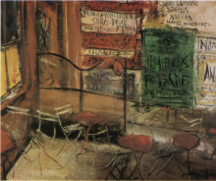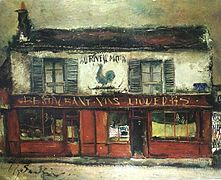Saeki Yūzō
Saeki Yūzō ( Japanese 佐伯 祐 三 ; April 28, 1898 in Nakatsu , Nishinari County (now Kita-ku , Osaka ), Osaka Prefecture - August 16, 1928 in Paris ) was a Japanese painter in the Yōga style .
life and work
Saeki was the second son of the priest Saeki Yūtetsu at the temple Kōtoku-ji ( 光 徳 寺 ) in Osaka. He began studying painting under Akamatsu Rinsaku (1878–1953) when he was still in middle school. In 1917 he was sent to Tokyo to continue studying at the Tōkyō bijutsu gakkō (today Tōkyō Geijutsu Daigaku ), u. a. under Fujishima Takeji . With fellow students he founded the "Rose Gate Society" ( 薔薇 門 社 Baramon-sha ), which organized a series of exhibitions in Kanda. In 1921 he married Ikeda Yoneko (1897–1972), who also studied painting. After finishing their studies in 1923, he and his wife decided to go to France with their child.
After arriving in Paris in January 1924, Saeki worked for a while at the Free Department of the Académie de la Grande Chaumière, where models were available but no instructions were given. In the summer his older friend, Satomi Katsuzō , who had been in France for a while, took him to visit Maurice Vlaminck in Auvers, the leading painter of Fauvism . Vlaminck criticized Saeki for his academic style, whereupon Saeki decided to take a new direction. Back in Paris he painted the city in a mixture of Vlaminck's strong expression and the more lyrical painting style of Utrillo , with which he became friends. The “Schuster” that he exhibited in the Salon d'Automne is an example of his direction.
In 1926 he was back in Japan and founded together with Satomi, Maeda Kanji (1896-1930) and other friends who knew each other from Paris, the "1930 Society" ( 1930 年 und 1930-nen kyōkai ). Saeki showed nineteen pictures taken in Europe at the 13th Nikakai exhibition and won a prize for them.
Since Saeki did not find enough inspiration in Tokyo, which was then largely made of wood, he decided to go back to Paris. After traveling on the Siberian Railway, he reached the country in August 1927. He worked restlessly until he collapsed in June 1928, then died in August, penniless in an asylum in the Paris suburbs.
photos
Remarks
- ↑ The name is said to be derived from a similarly named society in France, but a hundred years earlier.
- ↑ This picture was shown at the exhibition Japanese Painting in Western Style 1985 in the Museum for East Asian Art in Cologne.
literature
- Japan Foundation (Ed.): Japanese Painting in the Western Style, 19th and 20th Centuries. Exhibition catalog, Cologne, 1985.
- Tazawa Yutaka: Biographical Dictionary of Japanese Art . Kodansha International, 1981. ISBN 0-87011-488-3 .
- City of Tokyo and Asahi Shimbunsha (eds.): Meiji, Taisho kara Showa e. Kindai Nihon bijutsu no ayumi ten. (Catalog) Tokyo, 1979.
- Laurance P. Roberts: A Dictionary of Japanese Artists. Weatherhill, 1976. ISBN 0-8348-0113-2 .
Web link
| personal data | |
|---|---|
| SURNAME | Saeki, Yūzō |
| ALTERNATIVE NAMES | 佐伯祐 三 (Japanese) |
| BRIEF DESCRIPTION | Japanese painter |
| DATE OF BIRTH | April 28, 1898 |
| PLACE OF BIRTH | Nakatsu , Nishinari County (now Kita-ku , Osaka ), Osaka Prefecture |
| DATE OF DEATH | August 16, 1928 |
| Place of death | Paris |






